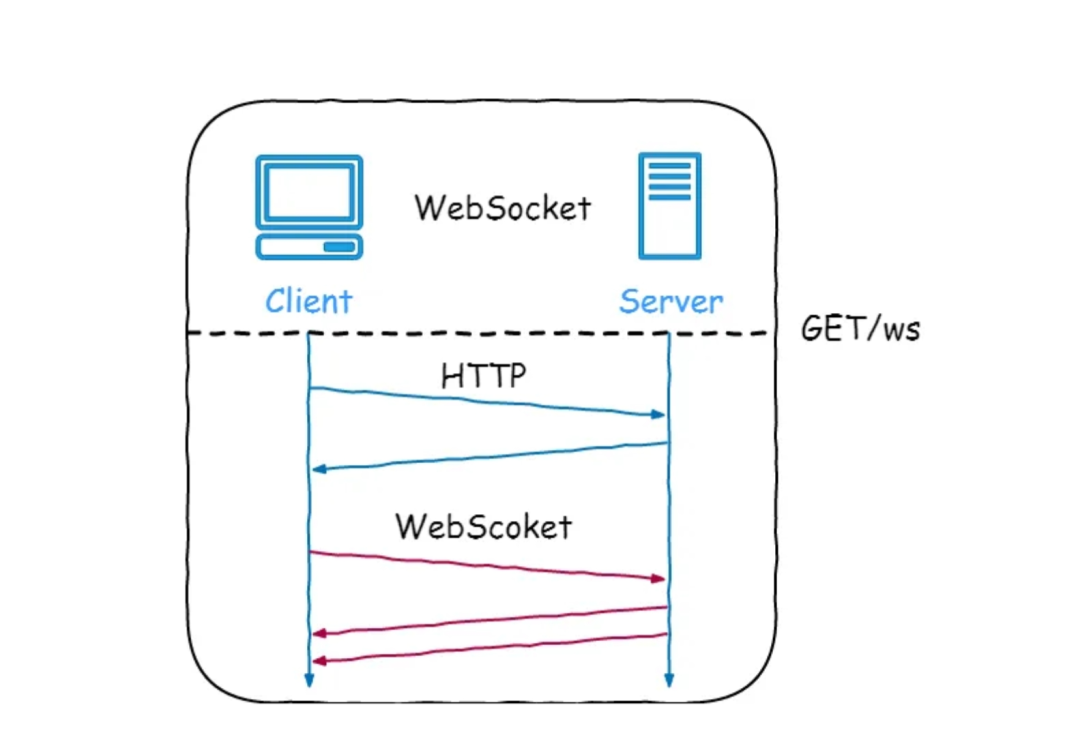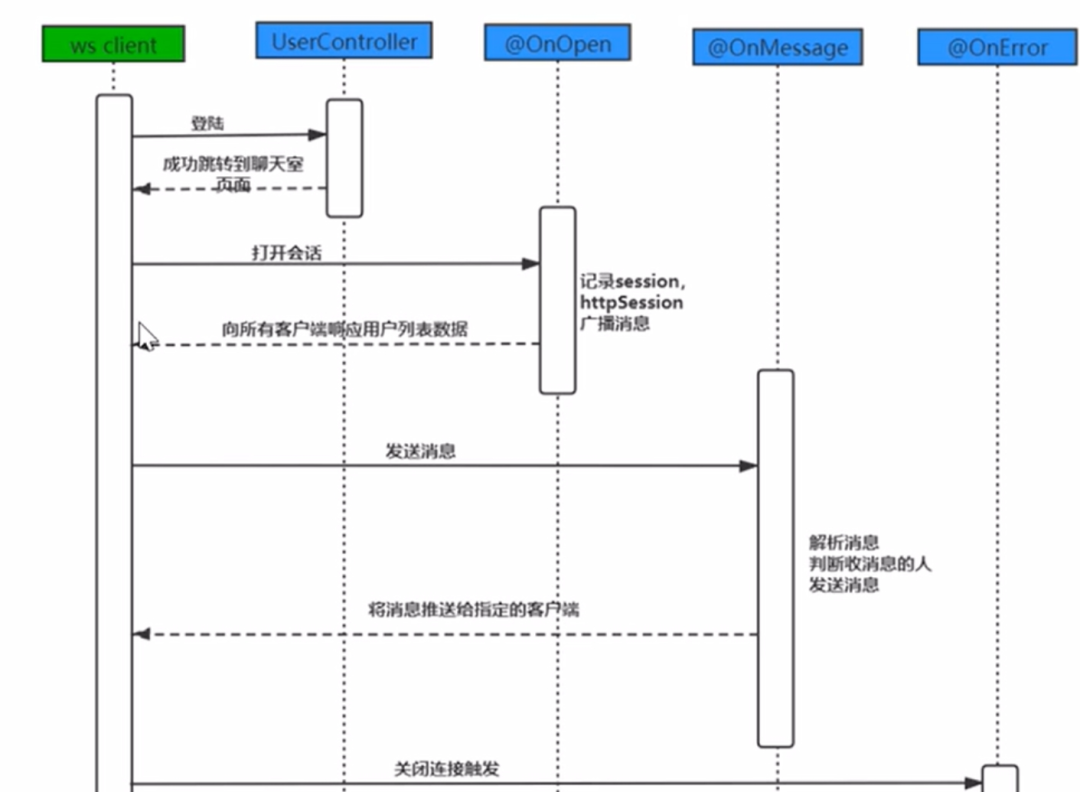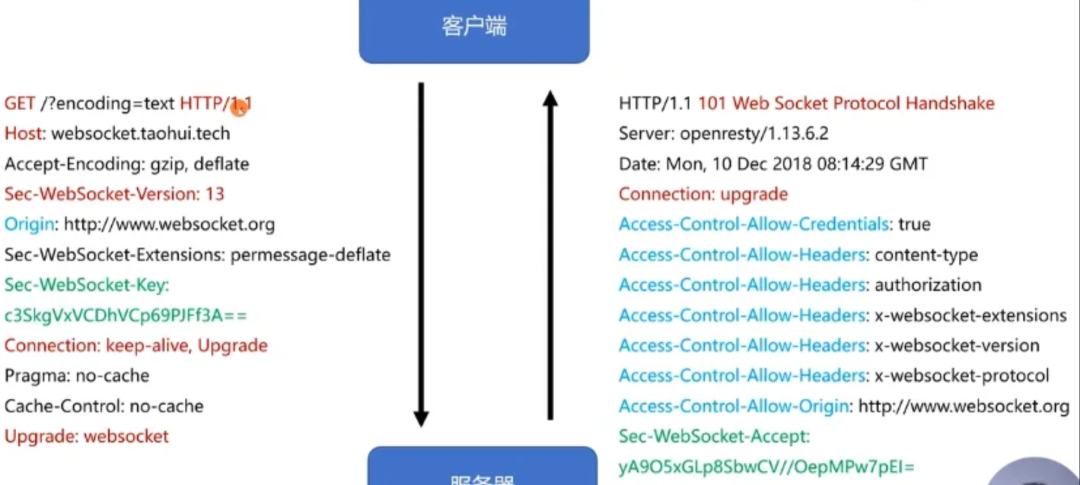SpringBoot整合WebSocket(看完即入门)

致力于最高效的Java学习
原文链接 https://blog.csdn.net/qq_48721706/article/details/124995148
1、什么是webSocket?
WebSocket是一种在单个TCP连接上进行全双工通信的协议。WebSocket使得客户端和服务器之间的数据交换变得更加简单,
允许服务端主动向客户端推送数据。在WebSocket API中,浏览器和服务器只需要完成一次握手,两者之间就直接可以创建持久性的连接,并进行双向数据传输。
2、webSocket可以用来做什么?
3、webSocket协议
GET ws://localhost/chat HTTP/1.1Host: localhostUpgrade: websocketConnection: UpgradeSec-WebSocket-Key:dGhlIHNhbXBsZSBub25jZQ==Sec-WebSocket-Protocol: chat,superchatSec-WebSocket-Version: 13
HTTP/1.1 101 Switching ProtocolsUpgrade: websocketConnection: UpgradeSec-WebSocket-Accept:s3pPLMBiTxaQ9kYGzzhZRbK+xOo=Sec-WebSocket-Protocol: chat
4、服务端
<dependency><groupId>org.springframework.boot</groupId><artifactId>spring-boot-starter-websocket</artifactId></dependency>WebSocket配置类
mport org.springframework.context.annotation.Bean;import org.springframework.context.annotation.Configuration;import org.springframework.web.socket.server.standard.ServerEndpointExporter;@Configurationpublic class WebSocketConfig {/*** 注入ServerEndpointExporter,* 这个bean会自动注册使用了@ServerEndpoint注解声明的Websocket endpoint*/@Beanpublic ServerEndpointExporter serverEndpointExporter() {return new ServerEndpointExporter();}}WebSocket操作类
import java.util.HashMap;import java.util.Map;import java.util.concurrent.CopyOnWriteArraySet;import javax.websocket.OnClose;import javax.websocket.OnMessage;import javax.websocket.OnOpen;import javax.websocket.Session;import javax.websocket.server.PathParam;import javax.websocket.server.ServerEndpoint;import org.springframework.stereotype.Component;import lombok.extern.slf4j.Slf4j;("/websocket/{userId}") // 接口路径 ws://localhost:8087/webSocket/userId;public class WebSocket {//与某个客户端的连接会话,需要通过它来给客户端发送数据private Session session;/*** 用户ID*/private String userId;//concurrent包的线程安全Set,用来存放每个客户端对应的MyWebSocket对象。//虽然@Component默认是单例模式的,但springboot还是会为每个websocket连接初始化一个bean,所以可以用一个静态set保存起来。// 注:底下WebSocket是当前类名private static CopyOnWriteArraySet<WebSocket> webSockets =new CopyOnWriteArraySet<>();// 用来存在线连接用户信息private static ConcurrentHashMap<String,Session> sessionPool = new ConcurrentHashMap<String,Session>();/*** 链接成功调用的方法*/public void onOpen(Session session, (value="userId")String userId) {try {this.session = session;this.userId = userId;webSockets.add(this);sessionPool.put(userId, session);log.info("【websocket消息】有新的连接,总数为:"+webSockets.size());} catch (Exception e) {}}/*** 链接关闭调用的方法*/public void onClose() {try {webSockets.remove(this);sessionPool.remove(this.userId);log.info("【websocket消息】连接断开,总数为:"+webSockets.size());} catch (Exception e) {}}/*** 收到客户端消息后调用的方法** @param message* @param session*/public void onMessage(String message) {log.info("【websocket消息】收到客户端消息:"+message);}/** 发送错误时的处理* @param session* @param error*/public void onError(Session session, Throwable error) {log.error("用户错误,原因:"+error.getMessage());error.printStackTrace();}// 此为广播消息public void sendAllMessage(String message) {log.info("【websocket消息】广播消息:"+message);for(WebSocket webSocket : webSockets) {try {if(webSocket.session.isOpen()) {webSocket.session.getAsyncRemote().sendText(message);}} catch (Exception e) {e.printStackTrace();}}}// 此为单点消息public void sendOneMessage(String userId, String message) {Session session = sessionPool.get(userId);if (session != null&&session.isOpen()) {try {log.info("【websocket消息】 单点消息:"+message);session.getAsyncRemote().sendText(message);} catch (Exception e) {e.printStackTrace();}}}// 此为单点消息(多人)public void sendMoreMessage(String[] userIds, String message) {for(String userId:userIds) {Session session = sessionPool.get(userId);if (session != null&&session.isOpen()) {try {log.info("【websocket消息】 单点消息:"+message);session.getAsyncRemote().sendText(message);} catch (Exception e) {e.printStackTrace();}}}}}
@Resourceprivate WebSocket webSocket;发送消息给前端
//创建业务消息信息JSONObject obj = new JSONObject();obj.put("cmd", "topic");//业务类型obj.put("msgId", sysAnnouncement.getId());//消息idobj.put("msgTxt", sysAnnouncement.getTitile());//消息内容//全体发送webSocket.sendAllMessage(obj.toJSONString());//单个用户发送 (userId为用户id)webSocket.sendOneMessage(userId, obj.toJSONString());//多个用户发送 (userIds为多个用户id,逗号‘,’分隔)webSocket.sendMoreMessage(userIds, obj.toJSONString());5、客户端
<script>import store from '@/store/'export default {data() {return {}},mounted() {//初始化websocketthis.initWebSocket()},destroyed: function () { // 离开页面生命周期函数this.websocketclose();},methods: {initWebSocket: function () { // 建立连接// WebSocket与普通的请求所用协议有所不同,ws等同于http,wss等同于httpsvar userId = store.getters.userInfo.id;var url = window._CONFIG['domianURL'].replace("https://","wss://").replace("http://","ws://")+"/websocket/"+userId;this.websock = new WebSocket(url);this.websock.onopen = this.websocketonopen;this.websock.send = this.websocketsend;this.websock.onerror = this.websocketonerror;this.websock.onmessage = this.websocketonmessage;this.websock.onclose = this.websocketclose;},// 连接成功后调用websocketonopen: function () {console.log("WebSocket连接成功");},// 发生错误时调用websocketonerror: function (e) {console.log("WebSocket连接发生错误");},// 给后端发消息时调用websocketsend: function (e) {console.log("WebSocket连接发生错误");},// 接收后端消息// vue 客户端根据返回的cmd类型处理不同的业务响应websocketonmessage: function (e) {var data = eval("(" + e.data + ")");//处理订阅信息if(data.cmd == "topic"){//TODO 系统通知}else if(data.cmd == "user"){//TODO 用户消息}},// 关闭连接时调用websocketclose: function (e) {console.log("connection closed (" + e.code + ")");}}}</script>
接口调用顺序,进来页面 :先建立连接–》调用websocketonopen方法,链接成功调用的方法websocketonmessage方法为接收后端时处理。
当我们要发送消息给后端时调用websocketsend。
当我们要关闭连接时调用websocketclose。
当发现错误时调用websocketonerror。浏览器查看日志:
朝上的绿色箭头是发出去的消息
朝下的红色箭头是收到的消息
评论






